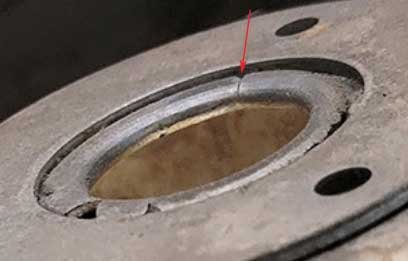Gentleman, I read all the posts under the topic (I have no idea how I made it! ;-) ) and maybe it would be helpful to sum up all the options to help new readers as for other DYI threads but maybe from 2015 it is still to early to make it complete? What do you think?
What is missing here in my humble opinion is the voice of few experts more which I know there are on this forum. Does this problem interests only part of the Members or this topic is somehow difficult to be summarized by the recommended method?
Looking on the damage Steve faced several years ago it looks for me (I'm no expert in car body topics) that the weakest points in shock mounts was:
a) few point welds holding upper place to the body "jar".
b) visible corrosion between the body steel and the upper place
It would make sense according to my experience.
Some of You were probably trying to separate two sheets of steel connected with spot welder.
There are two major scenarios/effect:
1. separation at the point weld - typically means insufficient quality of the welding
2. scratch like sheet metal damage on the line of many bending actions
Assuming car is running with stiff suspension on the bumpy road the forces are hitting that area and causing very specific damages: tearing the metal.
Following that, 2mm steel plus the plate are good enough, so the plates which were presented in the beginning as a repair have to work well.
I do agree change in the thickness (especially rapid) is worsening the situation.
Rounded pushed/stamped parts should be the best solution and cheapest for bigger orders.
If the damage is like on Steve's the pipe cap looks as the best solution once it will be very similar to original diameter but I would still recommend upper/lower reinforcement place welded where the shock absorber is mounted on top of the column.
Side topic:
Can anyone check if the diameter used on 2000CS or E10 are the same as for E9? That would be interesting as 2000cs was in fact built on E10 base. Unfortunately I have no access to any to be able to measure.
What is missing here in my humble opinion is the voice of few experts more which I know there are on this forum. Does this problem interests only part of the Members or this topic is somehow difficult to be summarized by the recommended method?
Looking on the damage Steve faced several years ago it looks for me (I'm no expert in car body topics) that the weakest points in shock mounts was:
a) few point welds holding upper place to the body "jar".
b) visible corrosion between the body steel and the upper place
It would make sense according to my experience.
Some of You were probably trying to separate two sheets of steel connected with spot welder.
There are two major scenarios/effect:
1. separation at the point weld - typically means insufficient quality of the welding
2. scratch like sheet metal damage on the line of many bending actions
Assuming car is running with stiff suspension on the bumpy road the forces are hitting that area and causing very specific damages: tearing the metal.
Following that, 2mm steel plus the plate are good enough, so the plates which were presented in the beginning as a repair have to work well.
I do agree change in the thickness (especially rapid) is worsening the situation.
Rounded pushed/stamped parts should be the best solution and cheapest for bigger orders.
If the damage is like on Steve's the pipe cap looks as the best solution once it will be very similar to original diameter but I would still recommend upper/lower reinforcement place welded where the shock absorber is mounted on top of the column.
Side topic:
Can anyone check if the diameter used on 2000CS or E10 are the same as for E9? That would be interesting as 2000cs was in fact built on E10 base. Unfortunately I have no access to any to be able to measure.


